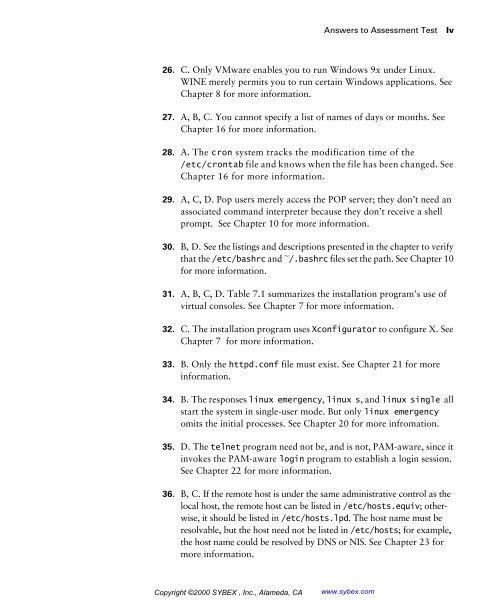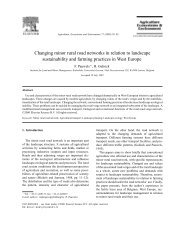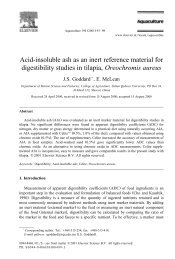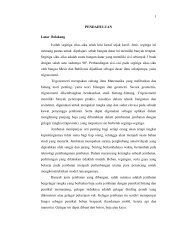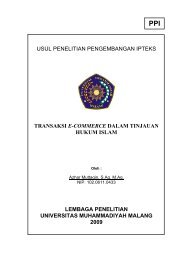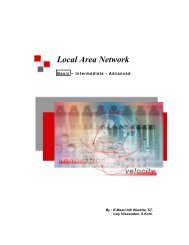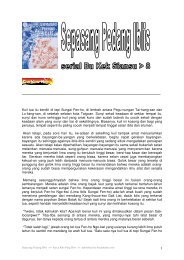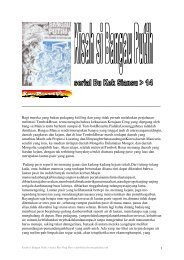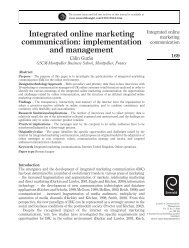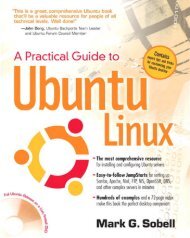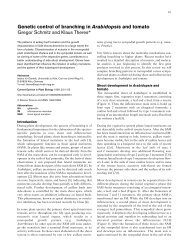- Page 1 and 2: RHCE: Red Hat Certified Engineer St
- Page 3 and 4: Associate Publisher: Jordan Gold Co
- Page 5 and 6: Acknowledgments This is my tenth bo
- Page 7 and 8: Introduction Like many in the Linux
- Page 9 and 10: How Do You Take the RHCE Exam? Intr
- Page 11 and 12: Introduction xxxix Appendix A Appen
- Page 13 and 14: xlii Assessment Test 5. Which of th
- Page 15 and 16: xliv Assessment Test 14. What is th
- Page 17 and 18: xlvi Assessment Test 22. Which of t
- Page 19 and 20: xlviii Assessment Test 31. Which of
- Page 21 and 22: l Assessment Test 41. Which of the
- Page 23 and 24: lii Assessment Test 50. The command
- Page 25: liv Assessment Test 13. A. You must
- Page 29 and 30: Background PART I
- Page 31 and 32: Though the Red Hat Certified Engine
- Page 33 and 34: 6 Chapter 1 � Red Hat Certificati
- Page 35 and 36: 8 Chapter 1 � Red Hat Certificati
- Page 37 and 38: 10 Chapter 1 � Red Hat Certificat
- Page 39 and 40: 12 Chapter 1 � Red Hat Certificat
- Page 41 and 42: 14 Chapter 1 � Red Hat Certificat
- Page 43 and 44: 16 Chapter 1 � Red Hat Certificat
- Page 45 and 46: Chapter 2 Hardware Basics RHCE PREP
- Page 47 and 48: Linux Support for Systems 21 The RH
- Page 49 and 50: Linux Support for Systems 23 CPU Ar
- Page 51 and 52: TABLE 2.1 Supported CPUs (continued
- Page 53 and 54: TABLE 2.2 Standard IRQ Assignments
- Page 55 and 56: Configuring Jumperless Cards Suppor
- Page 57 and 58: Keyboards Mice Support for Characte
- Page 59 and 60: � OPL3-SA2/3/x sound chip � Pro
- Page 61 and 62: IDE and EIDE Interfaces Support for
- Page 63 and 64: Support for Block Devices 37 IDE di
- Page 65 and 66: Key Terms Summary 39 Device Support
- Page 67 and 68: Review Questions Review Questions 4
- Page 69 and 70: Answers to Review Questions Answers
- Page 71 and 72: The installation and troubleshootin
- Page 73 and 74: 48 Chapter 3 � Unix Basics cp fin
- Page 75 and 76: 50 Chapter 3 � Unix Basics man Th
- Page 77 and 78:
52 Chapter 3 � Unix Basics rmdir
- Page 79 and 80:
54 Chapter 3 � Unix Basics TABLE
- Page 81 and 82:
56 Chapter 3 � Unix Basics able t
- Page 83 and 84:
58 Chapter 3 � Unix Basics Follow
- Page 85 and 86:
60 Chapter 3 � Unix Basics Most p
- Page 87 and 88:
62 Chapter 3 � Unix Basics You ca
- Page 89 and 90:
64 Chapter 3 � Unix Basics Creati
- Page 91 and 92:
66 Chapter 3 � Unix Basics /dev/h
- Page 93 and 94:
68 Chapter 3 � Unix Basics TABLE
- Page 95 and 96:
70 Chapter 3 � Unix Basics Enviro
- Page 97 and 98:
72 Chapter 3 � Unix Basics tests
- Page 99 and 100:
74 Chapter 3 � Unix Basics do com
- Page 101 and 102:
76 Chapter 3 � Unix Basics Key Te
- Page 103 and 104:
78 Chapter 3 � Unix Basics 5. To
- Page 105 and 106:
Chapter 4 Networking Basics RHCE PR
- Page 107 and 108:
Network Classes TCP/IP Networking 8
- Page 109 and 110:
Supernetting TCP/IP Networking 85 S
- Page 111 and 112:
FIGURE 4.1 The TCP/IP protocol laye
- Page 113 and 114:
UDP TCP TCP/IP Model 89 The UDP ena
- Page 115 and 116:
TABLE 4.1 Important TCP/IP Services
- Page 117 and 118:
TABLE 4.1 Important TCP/IP Services
- Page 119 and 120:
TABLE 4.2 Important Linux Daemons (
- Page 121 and 122:
TABLE 4.3 Important Linux Daemons U
- Page 123 and 124:
TCP/IP Model 99 Now complete Exerci
- Page 125 and 126:
Summary Summary 101 Now, complete E
- Page 127 and 128:
IP address loopback address netmask
- Page 129 and 130:
5. Which statement applies to port
- Page 131 and 132:
Chapter 5 History of Linux RHCE PRE
- Page 133 and 134:
The GNU Project and the Free Softwa
- Page 135 and 136:
The Linux Kernel 111 Hello everybod
- Page 137 and 138:
� Linux Knowledge Base, linuxkb.c
- Page 139 and 140:
Summary Key Terms Summary 115 In th
- Page 141 and 142:
Review Questions 117 5. Which of th
- Page 143 and 144:
Installation PART II
- Page 145 and 146:
Determining Needs Planning is an im
- Page 147 and 148:
124 Chapter 6 � Installation Plan
- Page 149 and 150:
126 Chapter 6 � Installation Plan
- Page 151 and 152:
128 Chapter 6 � Installation Plan
- Page 153 and 154:
130 Chapter 6 � Installation Plan
- Page 155 and 156:
132 Chapter 6 � Installation Plan
- Page 157 and 158:
134 Chapter 6 � Installation Plan
- Page 159 and 160:
136 Chapter 6 � Installation Plan
- Page 161 and 162:
138 Chapter 6 � Installation Plan
- Page 163 and 164:
This chapter explains how to instal
- Page 165 and 166:
142 Chapter 7 � Installing Red Ha
- Page 167 and 168:
144 Chapter 7 � Installing Red Ha
- Page 169 and 170:
146 Chapter 7 � Installing Red Ha
- Page 171 and 172:
148 Chapter 7 � Installing Red Ha
- Page 173 and 174:
150 Chapter 7 � Installing Red Ha
- Page 175 and 176:
152 Chapter 7 � Installing Red Ha
- Page 177 and 178:
154 Chapter 7 � Installing Red Ha
- Page 179 and 180:
156 Chapter 7 � Installing Red Ha
- Page 181 and 182:
158 Chapter 7 � Installing Red Ha
- Page 183 and 184:
160 Chapter 7 � Installing Red Ha
- Page 185 and 186:
162 Chapter 7 � Installing Red Ha
- Page 187 and 188:
164 Chapter 7 � Installing Red Ha
- Page 189 and 190:
166 Chapter 7 � Installing Red Ha
- Page 191 and 192:
168 Chapter 7 � Installing Red Ha
- Page 193 and 194:
170 Chapter 7 � Installing Red Ha
- Page 195 and 196:
172 Chapter 7 � Installing Red Ha
- Page 197 and 198:
This chapter covers some odds and e
- Page 199 and 200:
176 Chapter 8 � Advanced Installa
- Page 201 and 202:
178 Chapter 8 � Advanced Installa
- Page 203 and 204:
180 Chapter 8 � Advanced Installa
- Page 205 and 206:
182 Chapter 8 � Advanced Installa
- Page 207 and 208:
184 Chapter 8 � Advanced Installa
- Page 209 and 210:
186 Chapter 8 � Advanced Installa
- Page 211 and 212:
188 Chapter 8 � Advanced Installa
- Page 213 and 214:
190 Chapter 8 � Advanced Installa
- Page 215 and 216:
192 Chapter 8 � Advanced Installa
- Page 217 and 218:
194 Chapter 8 � Advanced Installa
- Page 219 and 220:
196 Chapter 8 � Advanced Installa
- Page 221 and 222:
198 Chapter 8 � Advanced Installa
- Page 223 and 224:
200 Chapter 8 � Advanced Installa
- Page 225 and 226:
Chapter 9 Configuring Install- Time
- Page 227 and 228:
FIGURE 9.1 The Configure Keyboard s
- Page 229 and 230:
FIGURE 9.3 The Configure Timezones
- Page 231 and 232:
Using linuxconf 209 The linuxconf s
- Page 233 and 234:
FIGURE 9.6 The Init Default Runleve
- Page 235 and 236:
FIGURE 9.7 The Changing Password sc
- Page 237 and 238:
Using linuxconf 215 You can add a n
- Page 239 and 240:
FIGURE 9.12 The Boot Mode Configura
- Page 241 and 242:
FIGURE 9.14 The Adapter 1 screen Us
- Page 243 and 244:
Summary 221 restarted. When you ins
- Page 245 and 246:
Review Questions Review Questions 2
- Page 247 and 248:
Answers to Review Questions Answers
- Page 249 and 250:
User Accounts One of the primary ta
- Page 251 and 252:
230 Chapter 10 � Administering Us
- Page 253 and 254:
232 Chapter 10 � Administering Us
- Page 255 and 256:
234 Chapter 10 � Administering Us
- Page 257 and 258:
236 Chapter 10 � Administering Us
- Page 259 and 260:
238 Chapter 10 � Administering Us
- Page 261 and 262:
240 Chapter 10 � Administering Us
- Page 263 and 264:
242 Chapter 10 � Administering Us
- Page 265 and 266:
244 Chapter 10 � Administering Us
- Page 267 and 268:
246 Chapter 10 � Administering Us
- Page 269 and 270:
248 Chapter 10 � Administering Us
- Page 271 and 272:
250 Chapter 10 � Administering Us
- Page 273 and 274:
252 Chapter 10 � Administering Us
- Page 275 and 276:
254 Chapter 10 � Administering Us
- Page 277 and 278:
256 Chapter 10 � Administering Us
- Page 279 and 280:
258 Chapter 10 � Administering Us
- Page 281 and 282:
260 Chapter 10 � Administering Us
- Page 283 and 284:
262 Chapter 10 � Administering Us
- Page 285 and 286:
264 Chapter 10 � Administering Us
- Page 287 and 288:
Quota Concepts The administrator of
- Page 289 and 290:
268 Chapter 11 � Implementing Use
- Page 291 and 292:
270 Chapter 11 � Implementing Use
- Page 293 and 294:
272 Chapter 11 � Implementing Use
- Page 295 and 296:
274 Chapter 11 � Implementing Use
- Page 297 and 298:
276 Chapter 11 � Implementing Use
- Page 299 and 300:
278 Chapter 11 � Implementing Use
- Page 301 and 302:
280 Chapter 11 � Implementing Use
- Page 303 and 304:
Chapter 12 Using RPM Packages RHCE
- Page 305 and 306:
FIGURE 12.1 The RPM facility Packag
- Page 307 and 308:
Adding Packages Adding Packages 287
- Page 309 and 310:
Adding Packages 289 If a package re
- Page 311 and 312:
Performing Updates and Fixes 291 Wh
- Page 313 and 314:
Determining File Ownership 293 To v
- Page 315 and 316:
Querying and Verifying Package Cont
- Page 317 and 318:
TABLE 12.1 Package Verification Fla
- Page 319 and 320:
Querying and Verifying Package Cont
- Page 321 and 322:
TABLE 12.2 Source File Flags of the
- Page 323 and 324:
Summary Summary 303 You should now
- Page 325 and 326:
Review Questions Review Questions 3
- Page 327 and 328:
Answers to Review Questions Answers
- Page 329 and 330:
A typical Red Hat Linux system hold
- Page 331 and 332:
312 Chapter 13 � Understanding th
- Page 333 and 334:
314 Chapter 13 � Understanding th
- Page 335 and 336:
316 Chapter 13 � Understanding th
- Page 337 and 338:
318 Chapter 13 � Understanding th
- Page 339 and 340:
320 Chapter 13 � Understanding th
- Page 341 and 342:
322 Chapter 13 � Understanding th
- Page 343 and 344:
324 Chapter 13 � Understanding th
- Page 345 and 346:
326 Chapter 13 � Understanding th
- Page 347 and 348:
Chapter 14 System Initialization RH
- Page 349 and 350:
The /etc/rc.d/rc.sysinit Script 331
- Page 351 and 352:
The /etc/rc.d/rc Script 333 During
- Page 353 and 354:
TABLE 14.2 Description of Common Ru
- Page 355 and 356:
The /etc/rc.d/rc Script 337 Now tha
- Page 357 and 358:
TABLE 14.3 Summary of Common Runlev
- Page 359 and 360:
The /etc/rc.d/rc Script 341 When a
- Page 361 and 362:
Adding a Service Associating Servic
- Page 363 and 364:
The /etc/rc.d/rc.local Script 345 s
- Page 365 and 366:
Key Terms Summary 347 Symbolic Link
- Page 367 and 368:
5. Which of the following tools can
- Page 369 and 370:
Chapter 15 Understanding Configurat
- Page 371 and 372:
The ifcfg-* Scripts The /etc/syscon
- Page 373 and 374:
The /etc/sysconfig Network Files an
- Page 375 and 376:
The /etc/sysconfig Network Files an
- Page 377 and 378:
Adding and Dropping Network Interfa
- Page 379 and 380:
The /etc/sysconfig Network Files an
- Page 381 and 382:
TABLE 15.4 Files and Directories in
- Page 383 and 384:
3. Issue the command Sound Configur
- Page 385 and 386:
TABLE 15.5 Linux File System Types
- Page 387 and 388:
TABLE 15.6 Mount Options (continued
- Page 389 and 390:
The /etc/inittab File The init Proc
- Page 391 and 392:
Summary ud::once:/sbin/update ca::c
- Page 393 and 394:
Review Questions Review Questions 3
- Page 395 and 396:
Answers to Review Questions Answers
- Page 397 and 398:
The cron System The cron system let
- Page 399 and 400:
382 Chapter 16 � Using the cron S
- Page 401 and 402:
384 Chapter 16 � Using the cron S
- Page 403 and 404:
386 Chapter 16 � Using the cron S
- Page 405 and 406:
388 Chapter 16 � Using the cron S
- Page 407 and 408:
390 Chapter 16 � Using the cron S
- Page 409 and 410:
392 Chapter 16 � Using the cron S
- Page 411 and 412:
394 Chapter 16 � Using the cron S
- Page 413 and 414:
396 Chapter 16 � Using the cron S
- Page 415 and 416:
Chapter 17 Understanding the Kernel
- Page 417 and 418:
Kernel Versions � Kernel-related
- Page 419 and 420:
Kernel Types Kernel Basics 403 Orig
- Page 421 and 422:
Kernel Basics 405 To build a custom
- Page 423 and 424:
The Kernel Source Tree Kernel Basic
- Page 425 and 426:
Module Location Kernel Modules 409
- Page 427 and 428:
Kernel Modules 411 where module is
- Page 429 and 430:
EXERCISE 17.7 (continued) 1. Make s
- Page 431 and 432:
path[net]=/lib/modules/default path
- Page 433 and 434:
Summary Summary 417 Now, complete E
- Page 435 and 436:
Review Questions Review Questions 4
- Page 437 and 438:
Answers to Review Questions Answers
- Page 439 and 440:
At one time, building a custom kern
- Page 441 and 442:
426 Chapter 18 � Configuring, Bui
- Page 443 and 444:
428 Chapter 18 � Configuring, Bui
- Page 445 and 446:
430 Chapter 18 � Configuring, Bui
- Page 447 and 448:
432 Chapter 18 � Configuring, Bui
- Page 449 and 450:
434 Chapter 18 � Configuring, Bui
- Page 451 and 452:
436 Chapter 18 � Configuring, Bui
- Page 453 and 454:
438 Chapter 18 � Configuring, Bui
- Page 455 and 456:
440 Chapter 18 � Configuring, Bui
- Page 457 and 458:
442 Chapter 18 � Configuring, Bui
- Page 459 and 460:
444 Chapter 18 � Configuring, Bui
- Page 461 and 462:
446 Chapter 18 � Configuring, Bui
- Page 463 and 464:
448 Chapter 18 � Configuring, Bui
- Page 465 and 466:
Next to the kernel and modules, the
- Page 467 and 468:
452 Chapter 19 � Managing Shared
- Page 469 and 470:
454 Chapter 19 � Managing Shared
- Page 471 and 472:
456 Chapter 19 � Managing Shared
- Page 473 and 474:
458 Chapter 19 � Managing Shared
- Page 475 and 476:
460 Chapter 19 � Managing Shared
- Page 477 and 478:
Chapter 20 Working in Single-User a
- Page 479 and 480:
Single-User Mode Single-User Mode 4
- Page 481 and 482:
Rescue Mode Rescue Mode 467 Now pra
- Page 483 and 484:
Rescue Mode 469 The boot disk conta
- Page 485 and 486:
Rescue Mode 471 In the example, par
- Page 487 and 488:
Rescue Mode 473 Inode table at 1638
- Page 489 and 490:
� /etc/lilo.conf � /etc/rc.d/*
- Page 491 and 492:
Key Terms Summary 477 Important Fil
- Page 493 and 494:
Review Questions 479 5. To check th
- Page 495 and 496:
V Network Services Administration P
- Page 497 and 498:
TCP/IP Services This chapter is one
- Page 499 and 500:
486 Chapter 21 � Installing and C
- Page 501 and 502:
488 Chapter 21 � Installing and C
- Page 503 and 504:
490 Chapter 21 � Installing and C
- Page 505 and 506:
492 Chapter 21 � Installing and C
- Page 507 and 508:
494 Chapter 21 � Installing and C
- Page 509 and 510:
496 Chapter 21 � Installing and C
- Page 511 and 512:
498 Chapter 21 � Installing and C
- Page 513 and 514:
500 Chapter 21 � Installing and C
- Page 515 and 516:
502 Chapter 21 � Installing and C
- Page 517 and 518:
504 Chapter 21 � Installing and C
- Page 519 and 520:
506 Chapter 21 � Installing and C
- Page 521 and 522:
508 Chapter 21 � Installing and C
- Page 523 and 524:
510 Chapter 21 � Installing and C
- Page 525 and 526:
512 Chapter 21 � Installing and C
- Page 527 and 528:
514 Chapter 21 � Installing and C
- Page 529 and 530:
516 Chapter 21 � Installing and C
- Page 531 and 532:
518 Chapter 21 � Installing and C
- Page 533 and 534:
520 Chapter 21 � Installing and C
- Page 535 and 536:
522 Chapter 21 � Installing and C
- Page 537 and 538:
524 Chapter 21 � Installing and C
- Page 539 and 540:
526 Chapter 21 � Installing and C
- Page 541 and 542:
528 Chapter 21 � Installing and C
- Page 543 and 544:
530 Chapter 21 � Installing and C
- Page 545 and 546:
532 Chapter 21 � Installing and C
- Page 547 and 548:
534 Chapter 21 � Installing and C
- Page 549 and 550:
536 Chapter 21 � Installing and C
- Page 551 and 552:
538 Chapter 21 � Installing and C
- Page 553 and 554:
The inetd Service In general, a hos
- Page 555 and 556:
542 Chapter 22 � Restricting Acce
- Page 557 and 558:
544 Chapter 22 � Restricting Acce
- Page 559 and 560:
546 Chapter 22 � Restricting Acce
- Page 561 and 562:
548 Chapter 22 � Restricting Acce
- Page 563 and 564:
550 Chapter 22 � Restricting Acce
- Page 565 and 566:
552 Chapter 22 � Restricting Acce
- Page 567 and 568:
554 Chapter 22 � Restricting Acce
- Page 569 and 570:
556 Chapter 22 � Restricting Acce
- Page 571 and 572:
558 Chapter 22 � Restricting Acce
- Page 573 and 574:
560 Chapter 22 � Restricting Acce
- Page 575 and 576:
562 Chapter 22 � Restricting Acce
- Page 577 and 578:
564 Chapter 22 � Restricting Acce
- Page 579 and 580:
In addition to the primary network
- Page 581 and 582:
568 Chapter 23 � Understanding Se
- Page 583 and 584:
570 Chapter 23 � Understanding Se
- Page 585 and 586:
572 Chapter 23 � Understanding Se
- Page 587 and 588:
574 Chapter 23 � Understanding Se
- Page 589 and 590:
576 Chapter 23 � Understanding Se
- Page 591 and 592:
578 Chapter 23 � Understanding Se
- Page 593 and 594:
580 Chapter 23 � Understanding Se
- Page 595 and 596:
582 Chapter 23 � Understanding Se
- Page 597 and 598:
584 Chapter 23 � Understanding Se
- Page 599 and 600:
586 Chapter 23 � Understanding Se
- Page 601 and 602:
Chapter 24 Administering Logs RHCE
- Page 603 and 604:
The klogd Process System Log Files
- Page 605 and 606:
� message is the message contents
- Page 607 and 608:
TABLE 24.1 Facilities and Their Des
- Page 609 and 610:
# The authpriv file has restricted
- Page 611 and 612:
Boot Log 599 CPU: AMD AMD-K7(tm) Pr
- Page 613 and 614:
Log Rotation 601 The logrotate comm
- Page 615 and 616:
Summary Summary 603 In this chapter
- Page 617 and 618:
Review Questions Review Questions 6
- Page 619 and 620:
Answers to Review Questions Answers
- Page 621 and 622:
A stand-alone computer that is kept
- Page 623 and 624:
612 Chapter 25 � Administering Se
- Page 625 and 626:
614 Chapter 25 � Administering Se
- Page 627 and 628:
616 Chapter 25 � Administering Se
- Page 629 and 630:
618 Chapter 25 � Administering Se
- Page 631 and 632:
620 Chapter 25 � Administering Se
- Page 633 and 634:
622 Chapter 25 � Administering Se
- Page 635 and 636:
Chapter 26 Installing and Configuri
- Page 637 and 638:
Installing X Installing X 627 X als
- Page 639 and 640:
TABLE 26.1 X Servers (continued) X
- Page 641 and 642:
XFree86-75dpi-fonts-*.rpm XFree86-x
- Page 643 and 644:
Configuring X 633 The following ste
- Page 645 and 646:
Configuring X 635 device. When you
- Page 647 and 648:
Configuring X 637 Select an appropr
- Page 649 and 650:
FIGURE 26.10 The Xconfigurator Cloc
- Page 651 and 652:
XF86Setup Configuring X 641 ask if
- Page 653 and 654:
� The Monitor button lets you con
- Page 655 and 656:
FIGURE 26.17 The XF86Setup Card scr
- Page 657 and 658:
FIGURE 26.19 The XF86Setup Monitor
- Page 659 and 660:
FIGURE 26.21 The XF86Setup Other sc
- Page 661 and 662:
SuperProbe Configuring X 651 The Su
- Page 663 and 664:
Summary Summary 653 Now complete Ex
- Page 665 and 666:
Review Questions Review Questions 6
- Page 667 and 668:
Answers to Review Questions Answers
- Page 669 and 670:
A suite of programs cooperates to p
- Page 671 and 672:
662 Chapter 27 � Understanding an
- Page 673 and 674:
664 Chapter 27 � Understanding an
- Page 675 and 676:
666 Chapter 27 � Understanding an
- Page 677 and 678:
668 Chapter 27 � Understanding an
- Page 679 and 680:
670 Chapter 27 � Understanding an
- Page 681 and 682:
672 Chapter 27 � Understanding an
- Page 683 and 684:
674 Chapter 27 � Understanding an
- Page 685 and 686:
676 Chapter 27 � Understanding an
- Page 687 and 688:
X Security One of the most useful f
- Page 689 and 690:
680 Chapter 28 � Configuring and
- Page 691 and 692:
682 Chapter 28 � Configuring and
- Page 693 and 694:
684 Chapter 28 � Configuring and
- Page 695 and 696:
686 Chapter 28 � Configuring and
- Page 697 and 698:
688 Chapter 28 � Configuring and
- Page 699 and 700:
690 Chapter 28 � Configuring and
- Page 701 and 702:
692 Chapter 28 � Configuring and
- Page 703 and 704:
Chapter 29 Configuring a Linux Rout
- Page 705 and 706:
Static Routing 697 interface to one
- Page 707 and 708:
Static Routing 699 Another way to e
- Page 709 and 710:
Static Routing 701 where ip_address
- Page 711 and 712:
Kernel Configuration The Flags fiel
- Page 713 and 714:
TABLE 29.1 Kernel Networking Option
- Page 715 and 716:
TABLE 29.1 Kernel Networking Option
- Page 717 and 718:
Summary � Open Shortest Path Firs
- Page 719 and 720:
Additional Sources of Information S
- Page 721 and 722:
Review Questions 713 4. Which of th
- Page 723 and 724:
Chapter 30 Configuring a Firewall U
- Page 725 and 726:
FIGURE 30.1 A typical firewall Masq
- Page 727 and 728:
FIGURE 30.3 The kernel packet path
- Page 729 and 730:
Implementing a Firewall by Using ip
- Page 731 and 732:
TABLE 30.3 ipchains Rules (continue
- Page 733 and 734:
Saving and Restoring ipchains Rules
- Page 735 and 736:
Additional Sources of Information S
- Page 737 and 738:
Review Questions 729 5. To block pa
- Page 739 and 740:
The RHCE Exam (RH302) PART VII
- Page 741 and 742:
The RHCE Exam The RHCE exam is no c
- Page 743 and 744:
736 Chapter 31 � The RHCE Exam Im
- Page 745 and 746:
738 Chapter 31 � The RHCE Exam
- Page 747 and 748:
740 Chapter 31 � The RHCE Exam Th
- Page 749 and 750:
Appendix A Practice Exam
- Page 751 and 752:
6. Which of the following statement
- Page 753 and 754:
Practice Exam 747 15. Which of the
- Page 755 and 756:
Practice Exam 749 24. Which of the
- Page 757 and 758:
Practice Exam 751 33. Which of the
- Page 759 and 760:
42. Which of the following programs
- Page 761 and 762:
Practice Exam 755 50. Which of the
- Page 763 and 764:
Answers to Practice Exam 757 11. A,
- Page 765 and 766:
Answers to Practice Exam 759 34. B.
- Page 767 and 768:
Shared Library File Ownership Table
- Page 769 and 770:
CP737 glibc CP775 glibc CSN_369103
- Page 771 and 772:
IBM851 glibc IBM852 glibc IBM855 gl
- Page 773 and 774:
LATIN-GREEK-1 glibc Leak mod_perl M
- Page 775 and 776:
grpmodule python imap php-imap init
- Page 777 and 778:
Shared Library File Ownership Table
- Page 779 and 780:
Shared Library File Ownership Table
- Page 781 and 782:
Shared Library File Ownership Table
- Page 783 and 784:
Shared Library File Ownership Table
- Page 785 and 786:
libldap openldap Shared Library Fil
- Page 787 and 788:
libnss1_files-2.1.2 glibc libnss1_n
- Page 789 and 790:
libpbm libgr Shared Library File Ow
- Page 791 and 792:
libresolv-2.1.2 glibc librle libgr
- Page 793 and 794:
Shared Library File Ownership Table
- Page 795 and 796:
Shared Library File Ownership Table
- Page 797 and 798:
mount_ext2 autofs mount_generic aut
- Page 799 and 800:
esource python rotormodule python r
- Page 801 and 802:
GNU General Public License
- Page 803 and 804:
GNU General Public License 819 Fina
- Page 805 and 806:
GNU General Public License 821 4. Y
- Page 807 and 808:
GNU General Public License 823 This
- Page 809 and 810:
GNU General Public License 825 If t
- Page 811 and 812:
2 Glossary A a.out The a.out format
- Page 813 and 814:
4 Glossary forwarding Forwarding is
- Page 815 and 816:
6 Glossary octet An octet is a seri
- Page 817:
8 Glossary three-button emulation T


